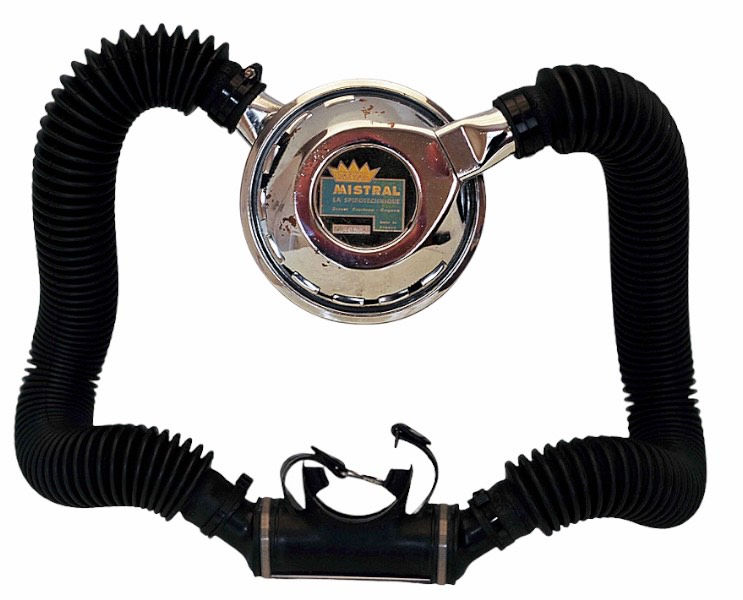
Chronology and typology of ROYAL MISTRAL regulators marketed from 1963 to 1985
In 1963, La Spiro launched the ROYAL MISTRAL regulator, the successor to the 1961 MISTRAL. It retained the corrugated hoses with contiguous coils and the improved version of the AQUASTOP mouthpiece, introduced in 1962. This mouthpiece now offset upwards, offered greater comfort thanks to the chin rest. New clamps with stainless steel screws were also designed to secure the corrugated hoses.
The regulator bowl was completely redesigned:
• The round exhalation holes were replaced by flanged openings, limiting the intrusion of foreign bodies that could damage the membrane.
• The manufacturer's label, now rivetless, was secured by a system of folded tabs, similar to that used in the United States. • Inside, the mechanism remains identical to that of the MISTRAL, with the exception of the Venturi nozzle, which has been modified to accommodate the revised bowl volume.
There are two generations of ROYAL MISTRAL:
1. First generation (1963-1979): recognizable by its crown-adorned label.
2. Second generation (1980-1985): equipped with a black label, without the COUSTEAU-GAGNAN inscription, displaying only the La Spirotechnique logo and its name in yellow.
THE FIRST GENERATION ROYAL MISTRAL

Détendeur ROYAL-MISTRAL première génération sans sortie HP et avec une plaque bleu marine et jaune dorée qui correspond aux premiers 10 000 exemplaires produits.

Détail de la plaque de la première génération de ROYAL MISTRAL. La première série produite en 1963 à une plaque aux couleurs bleu marin et jaune doré.

Les colliers de serrage en plastique avec vis en inox seront commercialisés de 1963 à 1971. À partir de 1972 et jusqu'en 1985 les tuyaux seront sertis avec des tie-rap ou serflex.

Détendeur ROYAL-MISTRAL PRO avec embout métal PRO.



Plaque de ROYAL-MISTRAL première génération avec le colorie correspondant à la période de 1972 à 1979.


Starting in 1972, as part of a modernization effort, the Royal-Mistral was equipped with a 6/100 HP outlet in France. Versions with and without HP outlets coexisted until 1979.
At the same time, models for the German and British markets received a male HP outlet with an imperial thread.
It is possible that the last French series were produced with a 3/8 HP outlet, but this remains uncertain. (Note that nowadays, 3/8 is used for low-pressure outlets, while high-pressure outlets are 5/16.)
THE ROYAL MISTRAL SECOND GENERATION

Détendeur ROYAL-MISTRAL seconde génération neuf, un des derniers produit.

Détail de la plaque du ROYAL-MISTRAL seconde génération. Il porte le numéro de série 58282, c'est le plus gros connu à ce jour.

Détail de la sortie HP du ROYAL-MISTRAL seconde génération.

Lettre de LA SPIROTECHNIQUE annonçant l'abandon de la vente de pièces détachées du détendeur MISTRAL et ROYAL-MISTRAL, elle date du 3 Décembre 1991.
In 1980, the Royal Mistral's manufacturer's label was completely modified following LA SPIROTECHNIQUE's decision to remove the COUSTEAU-GAGNAN designation from its regulators. It adopted the design of the series released in 1978, such as the 20, 25, 40, and 50 models.
This version, often referred to as the second generation or "Black Label" across the Atlantic, is believed to have been produced only with a 3/8 HP port. However, a model equipped with a 6/100 port has been found. Was this a custom modification or an exceptional production run by LA SPIROTECHNIQUE to meet a specific request? It's difficult to say.
This model would be the last Royal Mistral to be marketed. In 1985, its production was discontinued, deemed too expensive and technically outdated compared to the new mouthpiece regulators. Finally, in December 1991, LA SPIROTECHNIQUE definitively stopped selling its spare parts, thus marking the end of an era.
THE ROYAL MISTRAL MILITARY VERSION

Caisse de ROYAL MISTRAL militaire

Détail de la plaque de la caisse militaire

Ensemble ROYAL MISTRAL militaire

Le ROYAL MISTRAL militaire est entièrement chromé mate, plaque constructeur incluse.
This Royal Mistral model is a rarity. It's the military version. The entire regulator is matte chrome-plated. This model comes from the Lorient arsenal and was given to someone upon retirement.
It dates back to the 1970s.

